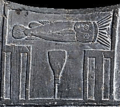Serekh facts for kids
A serekh was a special symbol used in Ancient Egypt. It was like a royal badge or crest that showed the name of the pharaoh (the king). It was very important for identifying the ruler.
Contents
What a Serekh Looked Like
A serekh usually had three main parts. At the bottom, it looked like the front of a palace or a tomb. This part is called a "niched façade." Above this, there was a space where the king's name was written. On top of the name, there was usually an animal. Most often, this animal was a falcon, which represented the god Horus.
Sometimes, instead of just the falcon, you might see a Seth animal (a mythical creature) either with the falcon or by itself. For example, King Peribsen had a serekh with only the Seth animal. King Khasekhemwy's serekh showed both the Horus falcon and the Seth animal together.
Each part of the serekh had a special meaning:
- The palace front at the bottom showed that the king owned important buildings like palaces or tombs. It also showed his power and wealth.
- The panel in the middle was where the king's name was written. This name was often called the king's "Horus name."
- The falcon on top represented the god Horus. Ancient Egyptians believed their kings were like a living version of Horus on Earth. So, having Horus on the serekh gave the king more authority.
Sometimes, the Horus or Seth animals wore crowns, like the red or white crown of Egypt. They could even be shown holding weapons! This made the serekh seem like it was actively protecting the king. Egyptians believed the king had a special spirit, or 'Ka,' from Horus. This spirit helped show that the king had the right to rule.
Serekhs were the main way to identify kings until about the Fourth Dynasty. After that, another symbol called a "cartouche" became more common. The word "serekh" itself comes from an Egyptian word meaning "facade" or "front of a building."
How Serekhs Were Used
Serekhs were used as royal symbols to show the pharaoh's name. They have been found from as far back as 3400 BC, even before the first pharaohs ruled all of Egypt. The king's name, written in hieroglyphs, was placed inside the rectangular part of the serekh.
A serekh was important not just while the king was alive, but also after he died. In ancient Egypt, having your name known meant you continued to exist. So, a serekh helped a king's legacy live on. Sometimes, serekhs were even shown with arms and hands, holding weapons or captives. This made it seem like the serekh itself was acting, showing that it truly represented the king.
Finding serekhs in different places also helps historians understand where ancient Egyptians traveled or expanded their influence. If a serekh was carved into a rock in a foreign land, it showed that Egyptians had been there.
Where Serekhs Were Found
Serekhs have been found on many different surfaces throughout history. They appear on large statues and important landmarks. But they are also found on simpler items like rocks and pottery.
Serekhs on less valuable materials, like pottery, often had less detail than those on fine stone like alabaster. The names on pottery serekhs were sometimes shortened. On rock carvings, serekhs were often placed next to other hieroglyphs or artistic scenes. The style of this surrounding artwork can help experts figure out how old a damaged serekh might be.
Images for kids
-
Example of a human-like Horus on the Narmer Palette.
-
Horus serekh, with many decorations.
-
Serekhs with symbols for King Narmer's name, around 3100 BC.
-
Serekh of Pharaoh Djet, from the 1st Dynasty. His name is inside the serekh, with the Horus falcon on top. This stone slab was from his tomb.
See also
 In Spanish: Serej para niños
In Spanish: Serej para niños






